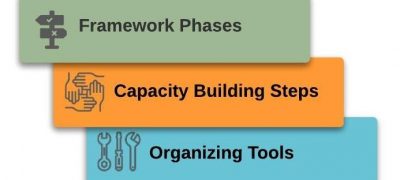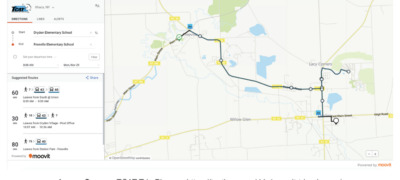This factsheet provides quick information drawn from N-CATT’s Promising Practices Guide.
Many technology-based innovations in transit have been largely restricted to large urban systems or dense urban areas. This has been changing in recent years, with a number of innovative implementations of new technology and service practices at small urban, rural, and tribal transit agencies. This Fact Sheet provides an overview of a selected set of “Promising Practices” that illustrate how at small urban, rural, and tribal transit agencies can work within their resources and capacities to research, analyze, and implement new solutions that could enhance their services. Promising practices may vary in nature and the types of benefits accrued to transit providers, but the themes below speak to agencies that are resourceful in seeking out not only new practices, but in finding ways to fund and implement new practices that are cost-effective and practical for small urban, rural, and tribal transit agencies.
A ‘Promising Practice’ has worked within at least one organization and shows promise during its early stages for becoming a recommended practice with long-term sustainable impact.
Partnerships
Partnerships that contribute to funding, staff hours, or expertise can be crucial in bringing a practice to fruition. Several of the promising practices profiled engaged with organizations outside of the transportation industry for assistance in funding or implementing their practice.
Vendor Research and Engagement
Promising practices are often the result of or benefit from extensive vendor research and engagement with vendors. Vendors that understand the needs and constraints of small-urban, rural, and tribal transit agencies have been able to create products scaled to their needs.
Stakeholder Involvement
Engagement from key external and internal stakeholders throughout promising practice development and implementation leads to success. Organizations representing key community stakeholders can help to shape the development of promising practices. Similarly, engagement with internal stakeholders helps to create practices that meet the needs and expectations of all invovled.
Planning
While all of the practices profiled resulted from careful planning, lessons learned shared by interviewees often related to additional elements of planning or preparation for implementation that would have benefited the initial implementation.
These findings are from the National Center for Applied Transit Technology’s Promising Practices Guidebook: Transit Technology Adoption. This N-CATT Guidebook is a resource to assist small urban, rural, and tribal transit agencies in understanding, selecting, and planning to incorporate innovative technology applications or service models into their service or operations. Ten case studies that examine a range of technology and service innovations from maintenance operations to fare payment to software interoperability are profiled, describing agencies’ experience and lessons learned in the implementation process. Brief descriptions of these ten practices are below.
Accessibility
- CARTA’s Wayfinder SMART Travel System: CARTA, the Tennessee Department of Intellectual and Developmental Disabilities (DIDD), the City of Chattanooga, the non-profit Orange Grove Center, and AbleLink Smart Living Technologies, LLC, formed a public-private partnership to develop an application to help individuals with intellectual disabilities navigate public transit independently.
- Michigan Mobility Challenge for Transit Providers to Improve Customer Service for the Visually- and Hearing-Impaired: After receiving a Michigan Mobility Challenge Grant, TheRide selected Feonix – Mobility Rising to develop the Connect app, which helps riders with visual and hearing impairments navigate public transit using What3Words.
Alternative Fuels
- Blue Lake Rancheria Transit System Waste Oil to Fuel: Blue Lake Rancheria Transit System constructed a biodiesel conversion apparatus that takes waste cooking oil from the Tribe’s hotel and casino kitchens and converts it into biodiesel. Locallyproduced biodiesel has been in use by the system since 2015.
- Clemson Area Transit Electric Bus Fleet: In 2014, CATbus started operating electric buses. By 2017, CATbus electric bus fleet represented half of its entire fleet and allowed for substantial operating savings.
Asset Management
- Mountain Line Asset Management Solution: Mountain Line uses an IoT-enabled Transit Asset Management (TAM) system, ThingTech, to improve the maintenance work order process by reducing manual data entry
Passenger Information and GTFS-Flex
- Go Vermont! Trip Planner: In 2018, Go! Vermont launched a trip planner that incorporated both GTFS and GTFS Flex, allowing the trip planner to provide more options than private-sector counterparts. The GTFS Flex function is especially useful in the rural parts of the state, where fixed-route bus services are less common than demand-response services.
CAD/AVL
- Portneuf’s Smartphone CAD/AVL and Fare Collection System: Portneuf, Quebec, Canada uses an off-the-shelf mobile-phone and tablet-based software to facilitate dispatching, vehicle location and to provide passengers with real-time information on vehicle location. The same software suite facilitates on-board fare payment with smartcards.
Fare Payment
- Mobile Fare Payment: Transit agencies can choose from a wide variety of fare payment and validation methods, business models, and companies to implement mobile fare payment systems. With mobile fares, riders download the app from a mobile app store, enter payment information or link the app with an existing transit account, board the vehicle, and validate their fares.
Microtransit
- Johnson County, Kansas, Flex Service Pilot: In 2019, Johnson County, Kansas, located in the Kansas City metropolitan area, implemented a demand-response service to connect residents to fixed-route transit. The service experienced rapid growth followed by a need to rapidly modify operations in response to COVID-19 in 2020.
Mobility Hubs
- City of Minneapolis Mobility Hubs: The Minneapolis Mobility Hubs Pilot increases access to convenient, low, or no carbon transportation options by creating centers where riders can transfer between these modes easily. Implemented in September of 2019, the original pilot covered 12 locations marked by specially designed wayfinding signs in North, Northeast, and South Minneapolis. Mobility hubs include seating, bikeshare docks, transit stops (often on high-frequency routes), and designated parking locations for dockless shared bikes and scooters.




